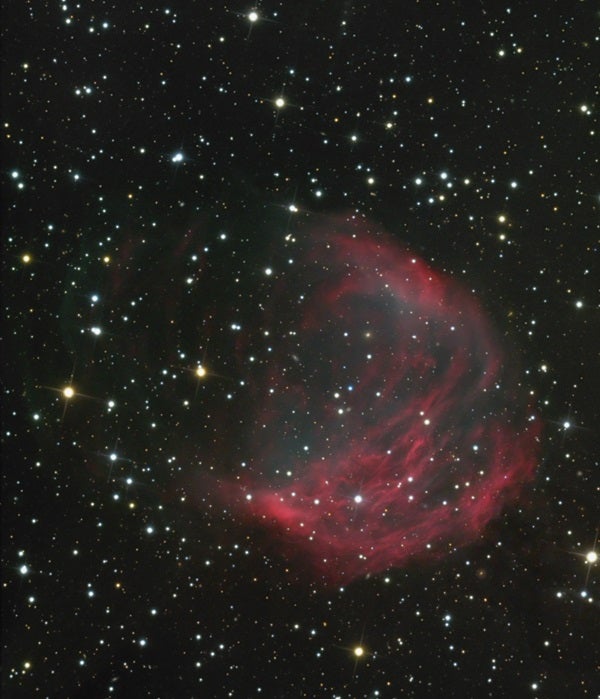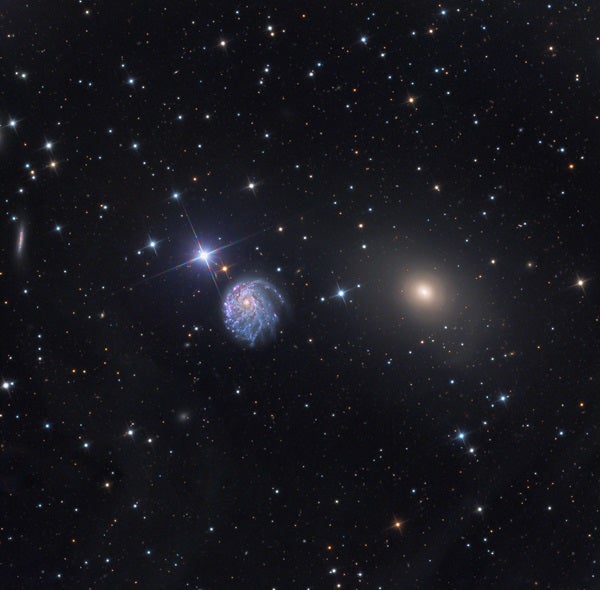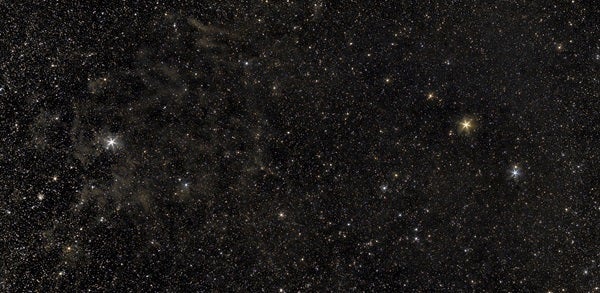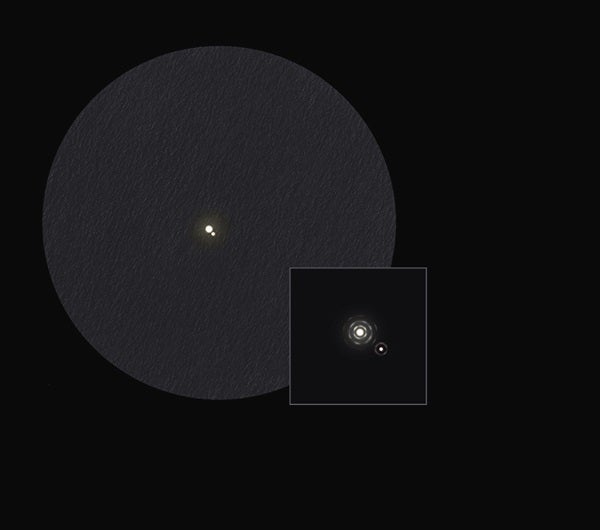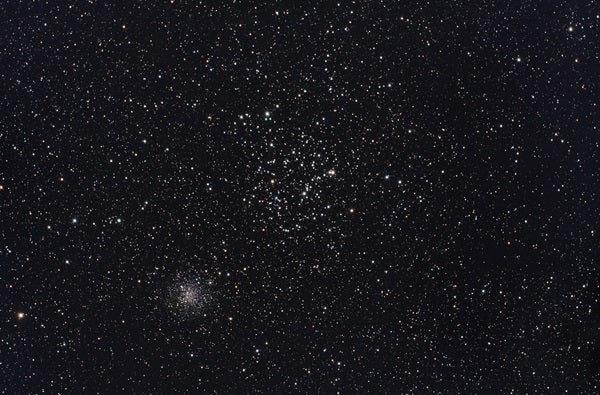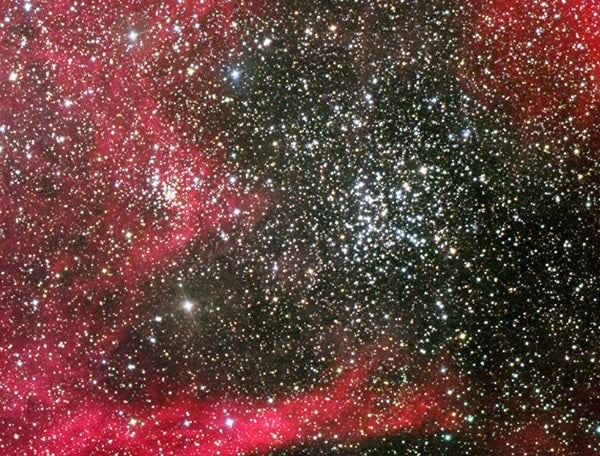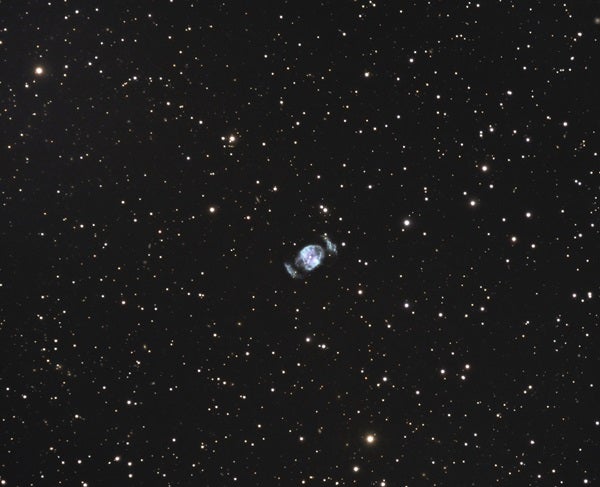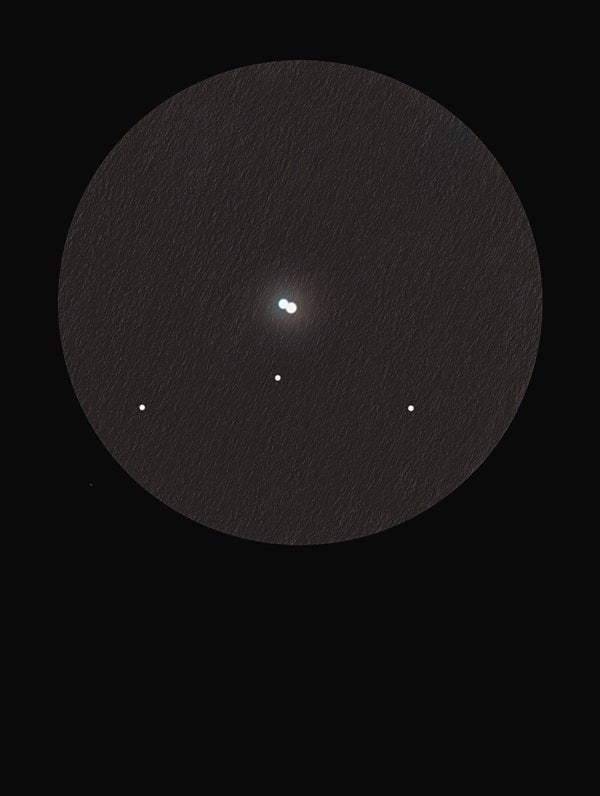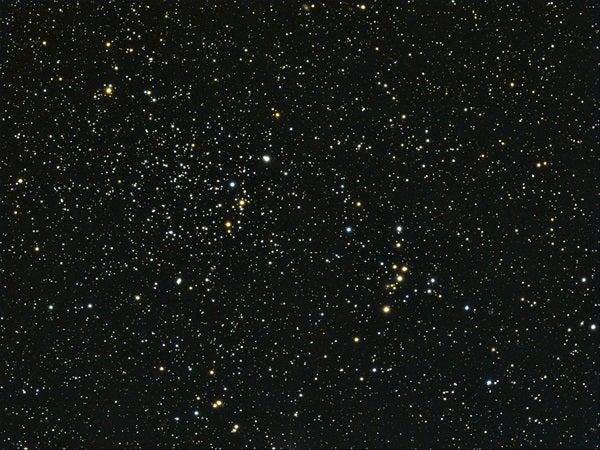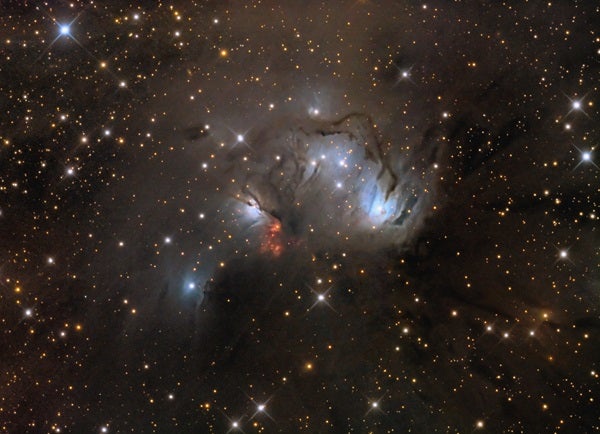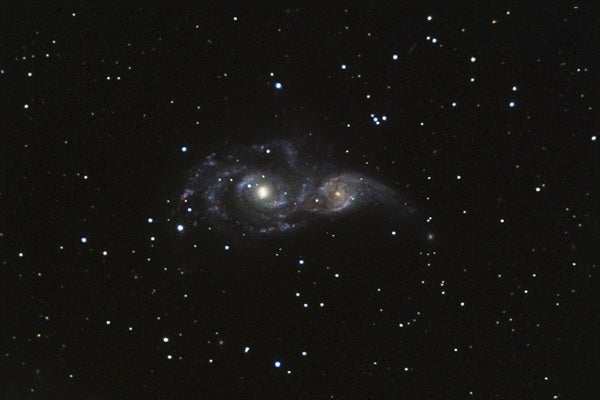Way up north
Alpha (α) Ursae Minoris, popularly known as Polaris, Stella Polaris, Lodestar, or the North Star, also has a deep-sky moniker: Struve 93 (Σ93), because it is a magnificent double star. Visible in a 2.4-inch refractor at 60x under excellent seeing conditions, Polaris AB is a celestial wonder that can be shared by all. The 2nd-magnitude golden primary has a 9th-magnitude secondary 19″ to the southwest. The secondary is white, but a contrast illusion may make it appear green or blue. In his and Wil Tirion’s beautiful The Cambridge Double Star Atlas, James Mullaney notes, with wit, that the pair displays a “24-hour orbital period” caused by Earth’s rotation.
Polaris is also part of a magnificent binocular asterism popularly known as the Engagement Ring. Look for a semicircle of eight conspicuous stars (6th magnitude and fainter) just southeast of Polaris, which not only completes the ring but represents its dazzling gem.
German astronomer Friedrich Winnecke discovered the pair in 1876 with a 6.5-inch refractor, although French astronomer Alphonse Borrelly had already found NGC 2300 some five years earlier with a 7-inch comet-seeker. Glowing at 11th magnitude, NGC 2300 is not only a full magnitude brighter than NGC 2276, but also 1′ smaller, making it more readily visible in backyard telescopes. The galaxy pair lies about 120 million light-years away and is separated in the sky by only 6′.
For those with larger telescopes, the non-interacting, magnitude 13.5 edge-on galaxy NGC 2634A lies 2′ south of NGC 2634. Anyone with a large-aperture, wide-field telescope might also challenge themselves to detect the wisps of Integrated Flux Nebula (IFN) — dust clouds illuminated by the background glow of the Milky Way. These clouds are most apparent southeast of NGC 2634 and run east to west. See the image of Polaris below for a good look at the IFN.
Auriga, Gemini, and Taurus
Third-magnitude Theta (θ) Aurigae, otherwise known as OΣ545 (the O stands for Otto), is a beautiful double star with a 7th-magnitude companion 4″ to the west-northwest. Don’t be fooled by the separation; the primary can visually subjugate the secondary under poor atmospheric seeing. It’s a great challenge for 4- to 5-inch telescopes at 250x.
Through an 8-inch, catching a glimpse of the aqua secondary — a contrast illusion because the star is white — hugging its yellow luminary lends a warming impression of a distant view of our Earth and Sun. For added enjoyment, check out Theta’s magnitude 11 C (line-of-sight) companion roughly 50″ farther to the west-northwest.
Nearly 6° west-southwest of Theta Aurigae lies a yin-yang “double cluster”: M38 and NGC 1907. Shining at magnitude 6.5, M38 is a wonder through any instrument, including binoculars. And some even can see it with the unaided eye. All powers reveal the 15′-wide cluster’s cross-shaped core (whose center is wreathed by scintillating starlight) and starfish arms. NGC 1907 lies in the same field of view 30′ to the south-southwest and appears merely as a compressed phantom glow at low power. At high magnification, it resolves into a rectangle of 30-odd suns crisscrossed with dark veins. Once considered to be physically related, the two clusters are only “flying by” one another, some 1,200 light-years apart.
M38 and NGC 1907 are a dimmer doppelgänger of M35 and NGC 2158 in northwestern Gemini. Only, in this case, M35 is the one with the rectangular shape. At 5th magnitude, M35 is visible to unaided eyes even from some suburban locations as a pale glow rivaling the apparent size of the Full Moon.
Just north of Orion’s Shield, we find another twin cluster treat: NGC 1807 and NGC 1817 in Taurus. At 33x in a 5-inch, these objects appear as two magnitude 7.5 knots of starlight separated by 20′. While NGC 1807 is 0.7 magnitude brighter than NGC 1817, it is less visually appealing, containing some two dozen stars in an area 12′ across and looking much like a stick figure.
NGC 1817 is a more dynamic grouping of irregularly bright suns — a lightning bolt of brighter members with direct vision that swells into a 20′-wide ball of noisy starlight with averted vision. These dueling objects may truly be twins — a single cluster nearly 1° across in the sky, with dual cores lying nearly 6,000 light-years distant.
Next, slip over to Castor (Alpha Geminorum or Σ1110), which is Gemini’s most famous twin wonder and one of the night sky’s most celebrated double stars. The 2nd-magnitude white primary has a hint of green, while its 3rd-magnitude secondary (5″ to the northeast) shines with a pale pumpkin light. Resolving the close pair requires medium to high magnifications on a night of steady seeing.
Near Gemini’s southern border, about 1¾° northwest of the magnitude 4.5 star 6 Canis Minoris, is the 8th-magnitude, low-surface brightness open star cluster NGC 2395. This loose and scattered aggregation of about 30 dim suns that form an ellipse lies in the same field of view as a planetary nebula just 30′ to the southeast: Abell 21 — more popularly known as the Medusa Nebula.
Southward
Next, move southwest into Monoceros. Just 1° west of Gamma (γ) Monocerotis, you’ll find a double “dwarf nebula”: NGC 2183 and NGC 2185. Through a 4-inch refractor at 72x, they appear as a tiny nebula glowing with a double nucleus. Actually, the double nucleus is the two nebulae, which appear to be hugging. NGC 2185 is the brighter and more easterly of the pair.
I hope you enjoyed this celestial soirée with these select twins of the night. The deep sky is filled with wonders like these, which help us better appreciate the depth, grandeur, and beauty of our infinite universe.

